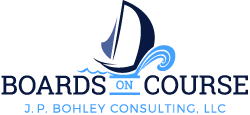Tip #75 What's the Board's Role in Strategic Planning?
In this Tip for Effective Boards, I would like to share how the Carver Policy Governance® model sees the role of the board in strategic planning. I am hopeful that boards not currently practicing this model may find the Policy Governance® view of this to be worth consideration.
In the Policy Governance® model, the board makes two major contributions to strategic planning:
1. The board defines the purpose of the organization in terms of what results it is to produce to positively impact what particular group or groups of people. The board policies that define organizational purpose are called Ends policies. Such policies do not identify management objectives but desired impacts on people. Such policies begin with a general statement that is followed by more specific statements giving further definition to results to be achieved and people to be impacted. An example of an Ends general statement for a school follows: “Our students will acquire the knowledge, skills, and attitudes necessary for student success.” More specific policy statements could then specify the knowledge, skills, and attitudes deemed necessary for student success. (For an overview of the concept of Ends policies and a complete example of an Ends policy, please check out Tips for Effective Boards #61: “What’s Your Organization’s Purpose” by clicking on https://www.BoardsOnCourse.com/blog.)
2. Through its Executive Limitations policies the board defines the boundaries within which the CEO is authorized by the board and empowered by the board to make decisions and take action. These boundaries define what situations, decisions, and actions are unacceptable to the board (even if these might produce desired outcomes). As long as they avoid the board-prohibited situations, decisions, and actions, CEOs are empowered to make decisions and take actions to run the organization and achieve the board-defined Ends. Such decisions and actions include the strategies, tactics, and action steps of a strategic plan designed to achieve the board-determined organizational Ends. The CEO also has the flexibility to modify the strategies, tactics, and action steps of a strategic plan as necessary to achieve the board-determined Ends (as long as the CEO choses such modifications that are compliant with the board’s Executive Limitations policies). So, the CEO gets to choose the strategies, tactics, and action steps of the strategic plan as long as these are compliant with board policy and is held accountable by the board for the successful accomplishment of Ends.
In order to define the organization’s Ends the board engages in foresight or future-oriented thinking. It looks beyond the time-frame of the organization’s current strategic plan because it is concerned about the longer-term relevance and viability of the organization. To return to our school example, the school board is concerned about what students will need to acquire (knowledge, skills, and attitudes) to lay the foundation for their success well into the future. As the board engages in ongoing future-oriented thinking, it assesses relevant trends and future possibilities in society in general and in the organization’s own business environment. (So, our school board is concerned about how society in general is changing and what students will need to be successful and how educational technology is evolving.) The board then regularly modifies its Ends policies (organizational purpose) to incorporate insights gained from its future-oriented analyses. Finally, Ends polices (modified as deemed necessary by the board) provide ongoing board guidance and direction for the CEO in developing and refining the strategies, tactics, and actions steps of a strategic plan.
To learn more about the Policy Governance® model, please click https://www.BoardsOnCourse.com/policy-governance.
